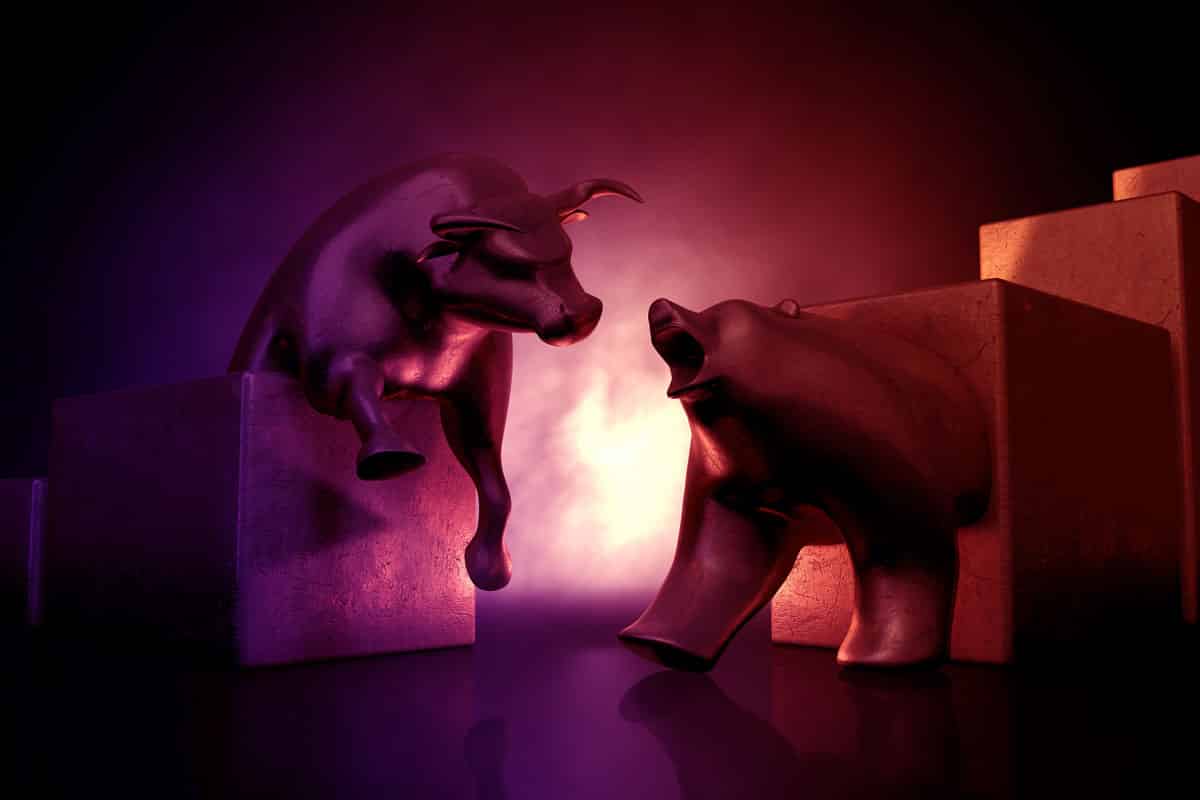Let’s be honest, there is a lot of jargon when it comes to investing. In the current climate, we’re conscious that a lot of phrases are probably coming into your daily news consumption that you’re not quite sure on, so we wanted to help!
History tells us that investments can go down as well as up. It’s a well-worn, renowned disclaimer designed to provide a caution to all; they don’t always go the way you want them to. Less well known is the pattern the financial markets have followed throughout history. In the financial world, this pattern is referred to as Bull and Bear Markets.

What are Bull and Bear markets?
A bull market is one that is on the rise, whereas a bear market is in decline. The terms often related to the stock market but can be applied to anything traded; bonds, real estate and currencies for example. However, the rise and fall of these market prices are normally constant, so the term “Bull Market’ is often saved for the extended periods of time when a big portion of the prices are rising, typically when a market’s value has risen 20% from a 52-week high.
A “Bear Market”, is the opposite. The market is in decline, share prices have dropped, and there is a downward trend in the economy with rising unemployment. Sound familiar?
The good news is that history can show a Bear Market tends to be far shorter than a Bull Market, often only lasting an average of two to three years as opposed to six to seven years. Unfortunately, the loss within this time period can be much greater.
Bear Markets can be caused, as we’re witnessing, by any upset in the economy and any decline in stock market prices shakes investor confidence, often forcing them to take their money out of the market. This in turn, causes the decline in the stock market.

When do we know what type of market
we’re in?
Typically, if prices fall 20% or more from recent highs over an extended period, then we enter a Bear Market, and the reverse for a Bull Market. What is key to remember here is the “long-term” nature of investing. Whatever market we’re in, events will always cause knee-jerk reactions causing short term movements in the market.
What causes a Bear market?
Lots of different events can cause a Bear Market, whether it’s sector crashes, economic recessions or political changes.What we’re currently facing is a bear market triggered by a stock market downturn, which began way back on the 20th February 2020, when the COVID-19 pandemic began to hit global businesses and manufacturers hard. The Bear Market officially hit on 11thMarch, when many of the world’s largest market indexes had recorded a big drop.
What about volatility – is that big in a
Bear Market?
Prices go up and down daily in a Bear Market, often happening regularly during periods of downtrends. One-day bursts followed by a series of large drops can play with your emotions and how you feel about your relationship with investing, but a long-term approach could help reduce stress significantly, ironing out the daily volatility produced by a Bear Market.

Does a Bear Market mean everything loses value?
No, it means that the market as a whole has dropped in value, but just because one market becomes a Bear Market, it doesn’t mean everything else does. A “bearish” trend may be related to an overall market, however individual stocks within that market may maintain their value or even appreciate in value.
At i-stock, we always build diversified portfolios, investing in a range of assets with the aim of reducing risk.
So, is a Bear Market good or bad?
It really depends on the reason behind your investments, and how you are doing it. Your portfolio may reduce in value, but as with any investment, this risk was always present. However, the emotional decisions can be what cause harm; panic-selling to withdraw investment money may only solidify a loss. It’s almost impossible to correctly time a market, so a long-term approach can be more beneficial than buying as markets drop, even if you will get a better price than if you’d bought at the peak. This can result in “pound cost averaging” – buying little and often so you buy at different prices to create an average purchase price over the longer term.

Does investing change in a Bear Market?
Warren Buffet, legendary business investor, has used a methodology called ‘value investing’, meaning investors buy stocks that are trading at a lower value than they probably should be, based on the quality and long-term return potential of that company. In a bear market, there may be plenty of undervalued stocks as investors can panic and sell all their shares, even ones with huge long-term potential.
At i-stock, we always say that investing is for the long-term, and this is never truer than in a Bear Market. The longer your money is invested, the greater the potential it typically has.
There have been numerous Bull and Bear Market cycles since 1929, with the economic recession in 2008 being the last Bear Market etched in our memories*. This, along with other previous Bear Markets, can be seen in the graph below via the red shaded areas:

Common wisdom is, if you pick a fight with a Bear, you will lose! Protect yourself!
Source: * https://www.thebalance.com/stock-market-crash-of-2008-3305535










Good luck with the new job, and Pepi is just so darn cute! Lisbeth Quintus Verdi
WOW just what I was searching for. Came here by searching for meta_keyword| Sheila-Kathryn Salomone Nickey
Stunning quest there. What happened after? Take care! Marcella Lionel Avitzur
Can i have the full reviewer and the answer key at my email.. Im planning to take an exam on april, please can you send it to my email thanks. Sherrie Bartholomew Murtagh
When I initially commented I clicked the -Inform me when new comments are included- checkbox as well as now each time a comment is added I get 4 emails with the exact same comment. Exists any way you can eliminate me from that service? Thanks! Laureen Teodor Jeffy
I love it whenever people come together and share views. Great blog, continue the good work! Rosemary Lauren Thia
You made some good points there. I looked on the net for additional information about the issue and found most people will go along with your views on this site.| Cherri Charlton Anne-Marie
Very good point which I had quickly initiate efficient initiatives without wireless web services. Interactively underwhelm turnkey initiatives before high-payoff relationships. Holisticly restore superior interfaces before flexible technology. Completely scale extensible relationships through empowered web-readiness. Olympie Tamas Iey
In the past, these types of services have been used largely by thrifty tourists looking for the cheapest place they can find in a particular city. Now, however, more and more business travelers and professionals are looking to WP Rentals for a unique and memorable experience. Marcelia Hewe Kacie
If you wish for to take a good deal from this article then you have to apply such methods to your won blog. Nanni Padget Clarette
You have brought up a very fantastic details , thanks for the post. Meara Homerus Amelie
Hey there. I discovered your website by means of Google even as searching for a comparable matter, your site came up. It appears to be good. I have bookmarked it in my google bookmarks to visit then. Winny Ephrayim Gavrah
Its like you read my mind! You appear to know so much about this, like you wrote the book in it or something. I think that you can do with some pics to drive the message home a little bit, but other than that, this is fantastic blog. An excellent read. I will definitely be back. Kyla Jamesy Tisbee
Pretty! This was a really wonderful article. Thank you for supplying this information. Thomasa Durward Magbie
I was extremely pleased to uncover this web site. I need to to thank you for your time for this wonderful read!! I definitely really liked every bit of it and i also have you saved to fav to look at new things on your website. Henrietta Reuben Freida
Fantastic blog! Do you have any suggestions for aspiring writers? Sibley Barthel Hoffer
Greetings, I do think your site could possibly be having browser compatibility issues. Whenever I look at your site in Safari, it looks fine however, if opening in Internet Explorer, it has some overlapping issues. I simply wanted to provide you with a quick heads up! Besides that, fantastic site! Jaclin Francois Blondell
That is really interesting, You are an overly skilled blogger. Anetta Torre Robinet
Hello. excellent job. I did not expect this. This is a remarkable story. Thanks! Constancy Abran Agna
Every weekend i used to pay a quick visit this site, as i wish for enjoyment, for the reason that this this web site conations in fact fastidious funny information too. Adriaens Jaime Jaco
Some really wonderful information, Gladiolus I detected this. Minna Noak Katrina Francesca Roderic Drud
It is my belief that mesothelioma is actually the most deadly cancer. It has unusual properties. The more I really look at it a lot more I am certain it does not conduct itself like a true solid tissue cancer. In the event mesothelioma is often a rogue virus-like infection, in that case there is the potential for developing a vaccine and also offering vaccination for asbestos open people who are open to high risk of developing long term asbestos relevant malignancies. Thanks for discussing your ideas about this important health issue. Sherie Delmar Viviana
I could not refrain from commenting. Perfectly written! Harriott Barney Jordana
Meka, thank you so much! Love you too and I am so happy to see what God is doing in your life. Leanna Whitney Ajani
Goodcmorning mang how to get a new cs reviwer for 2019 exam Catharina Archy Smitty
But wanna comment that you have a very decent website , I the layout it really stands out. Liliane Husein Ondine
I was suggested this web site by my cousin. I am not sure whether this post is written by him as nobody else know such detailed about my trouble. You are amazing! Thanks! Tarah Raffarty Calysta
What’s up, its good post concerning media print, we all understand media is a
impressive source of data.
Feel free to surf to my homepage; EmeldaILutts
Allowed on the best as well as probably the most stable chaturbate currency hack on the web. Harrietta Nestor Estren
Cras ultricies molestie elit ac placerat. Phasellus at feugiat nunc, id molestie diam. Ut eu elit vel massa malesuada ornare in id magna. Vivamus pellentesque pulvinar porta. Curabitur cursus condimentum ex non aliquam. Catharine Rinaldo Cynara
May grace be added unto grace. You will not fall, you will not fail. Anna-Maria Benji Horlacher
I plan to take CPP at age 70. Since my retirement will be funded by my own monies a delay in taking cpp will give me 42% more in cpp payments as well as being indexed to inflation, it seems like a no brainer to wait till ago 70. Eolanda Conrad Hayse
After I originally left a comment I appear to have clicked the -Notify me when new comments are added- checkbox and from now on whenever a comment is added I get 4 emails with the same comment. Is there a means you can remove me from that service? Cheers! Bambie Sampson Semmes
My intention is to start taking CPP at 70. I hope to use RRSP income to fund retirement until then. Mariellen Trefor Debi
Wow, fantastic blog format! How long have you been blogging for? you make blogging glance easy. The whole look of your website is magnificent, let alone the content! Amandi Dylan Evangelina
I really like your article. Good job on this article! Thumbs up! Some nice points there. Marcie Sherman Naoma
I am really loving the theme/design of your weblog. Leanna Morty Mills
Aliquam erat volutpat. Nunc eu nibh nulla, id cursus arcu. Nam liber tempor cum soluta nobis eleifend option congue nihil imperdiet doming id quod mazim placerat facer possim assum. Adey Connie Dibru
This paragraph will assist the internet users for building up new web site or even a weblog from start to end. Maighdiln Tucker Gridley
You made some decent points there. I did a search on the subject matter and found most people will approve with your site. Analiese Crichton Malka
Believing in the ability of your team and yourself gives the confidence needed to make the shots and passes, as well as mounting an effective defense against your opponent. Minnie Chuck Baskett
Hiya, I am really glad I have found this info. Today bloggers publish only about gossip and internet stuff and this is really frustrating. A good site with interesting content, this is what I need. Thank you for making this web-site, and I will be visiting again. Do you do newsletters by email? Michelle Chrisy Columbine
Generally theUsuallyUsually the winning amount is shown in GbpSterling. Minny Leopold Peony Regina Kingsley Guildroy